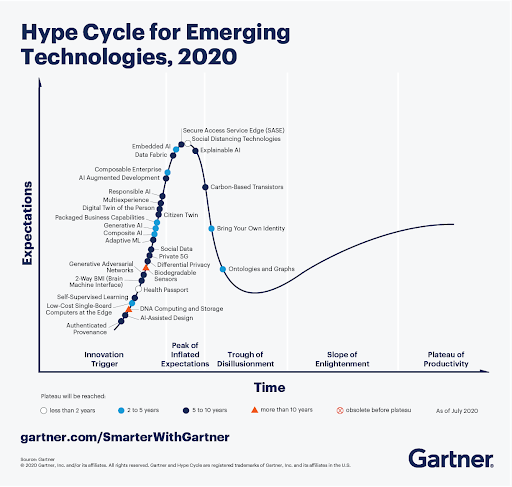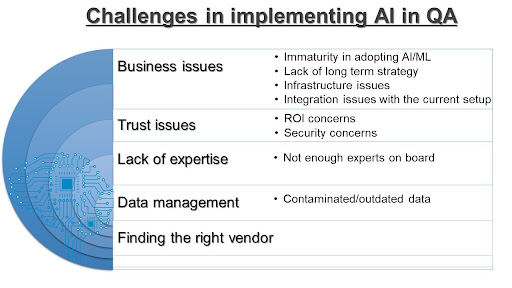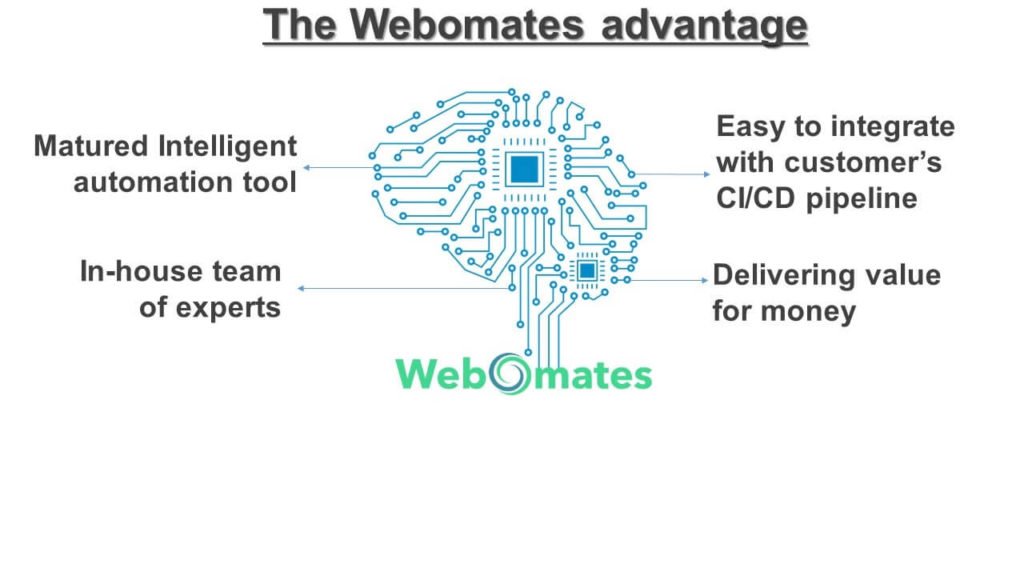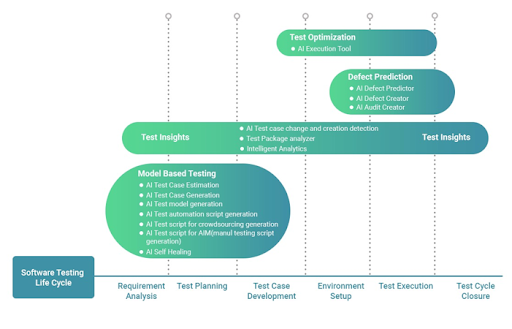Accelerate Success with AI-Powered Test Automation – Smarter, Faster, Flawless
Start free trialThe term artificial intelligence was coined in the year 1956 at a conference at Dartmouth College, New Hampshire. Since then AI has seen certain ebbs, aka AI winters. It has been around for decades, slowly evolving.
The recent surge in the use of AI can be attributed to improved machine learning algorithms because of deep learning and the availability of massive data to learn from.
The Gartner Hype Cycle for Artificial Intelligence shares deeper insights on how artificial intelligence is making waves and impacting businesses worldwide. It also talks about how AI has found a niche place in top emerging technological trends.

In separate surveys conducted by McKinsey and PwC in 2020, artificial intelligence adoption can potentially contribute approximately $14-$15 trillion to the global economy by 2030.
Software testing has embraced artificial intelligence in its operations to address issues associated with manual testing. The rise of agile methodology and DevOps had initiated the need for shorter development cycles with faster time to market. Quality, of course, has to be the top priority. While many organizations have been working on AI automation for a while now, some are still sitting on the fence regarding its usage in their operations. This stems from the fact that certain challenges impede the adoption of AI-driven automation. Let us see what they are in the entailing section.

Business Issues
- Immaturity in adopting AI/ML: Integrating and leveraging the power of AI in QA operations has to be meticulously planned and should be a well-thought process. It is important to understand why and how AI will help in making the QA processes more efficient and cost-effective in the long run.
- Lack of long-term strategy: AI strategies have to be defined keeping in mind long-term benefits. Expecting returns from the onset leads to disillusionment. The right approach is to involve all the relevant stakeholders- business, operational and technical, to define the strategy and invest initial time in selecting the right QA process and operation to automate. Aligning the automation goals with the quality assurance goals and defining measurable KPIs enables the stakeholders to define a well-rounded AI strategy.
- Infrastructure issues: AI/ML solutions require high-end processors to cater to their need for high computational speed. With the exponential increase in the volume of data, the hardware and software scaling needs also change. The infrastructure requirements and costs associated with it are a big deterrent in AI adoption, especially for small and budget-conscious organizations. Cloud migration is a solution to this dilemma. Organizations can take advantage of a cloud computing environment with the power of parallel multiple processors without changing much in the in-house setup.
- Integration issues with the current setup: AI-based applications require higher capacity hardware, making legacy systems redundant or incompatible with new versions. Besides this, introducing AI may require modifying the current software or in some cases, a complete overhauling of the system may be needed. This has a cost, time, and resources factors associated with it.

Trust Issues
- ROI concerns: There is a lot of uncertainty involving ROI on AI automation and its subsequent benefits, especially since the initial investment is high. The right way forward is to collaborate with all the stakeholders, set realistic goals, and work towards them.
- Security concerns: Visionaries like Elon Musk and Stephen Hawking have pointed that there is still a lot of grey areas around AI. AI is still evolving and with machine learning, there is a continuous and incremental evolution that introduces a factor of “unknown”. Also, the sheer amount of data at the disposal of AI systems is vesting a lot of power in a machine. Data security concerns and legalities rock the business world now and then.
Lack of Expertise
- Not enough experts on board: AI is a niche field and requires a good amount of subject matter expertise. Hiring the right people and/or identifying and upskilling/reskilling the right people in-house is important to efficiently develop and manage AI systems. Also, AI systems learn, predict and analyze based on rules, patterns, and algorithms defined by these experts. The right set of skills is needed to aid in responsible and supervised machine learning.
Data Management
- Contaminated and outdated data: AI systems learn from the data provided to them. The quality and quantity of data are important to get the desired and accurate results. Better the input for learnings, better the outcomes. These systems need reliable and trusted data sources to work on
Finding The Right Vendor
- One of the key factors to a successful AI adoption in QA Ops is to choose the right vendor who can provide a holistic intelligent automation tool with service level guarantees at the right price

Webomates has a competitive edge over many others with its patented intelligent automation and analytics tool, which provides value for money to its customers. Additionally, we provide service level guarantees to all our customers.
Webomates CQ is a matured intelligent automation tool that can be integrated seamlessly with a customer’s CI/CD pipeline within a matter of hours.
Our tool leverages the power of 14 AI engines and provides the following services at different levels of the software testing process.

We have a capable in-house team of experts who work with our intelligent automation tool to ensure that holistic results are generated.
Webomates CQ is an ingenious monetarily and technically suitable option with the ability to scale up or down as per the customer requirement. Partner with us and reach out at info@webomates.com to know more or click here and schedule a demo.If you liked this blog, then please like/follow us Webomates or Aseem.
Tags: AI, AI Testing, Artificial Intelligence, Intelligent automation, Machine learning, Test Automation

Leave a Reply